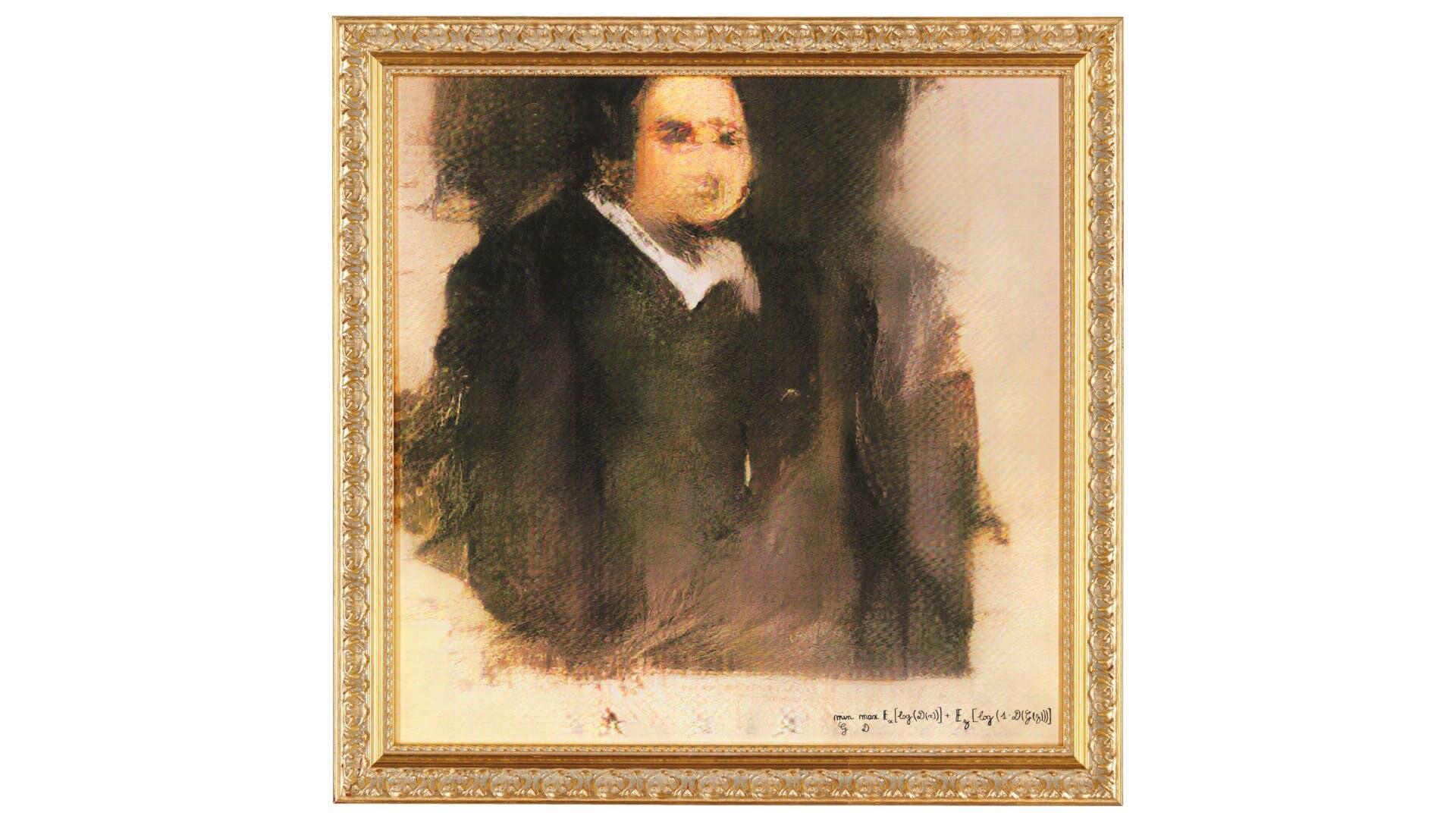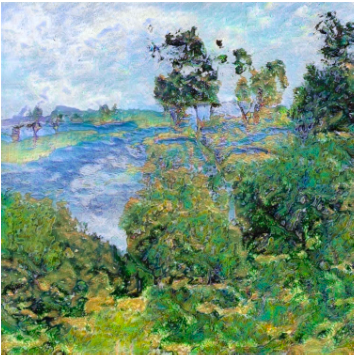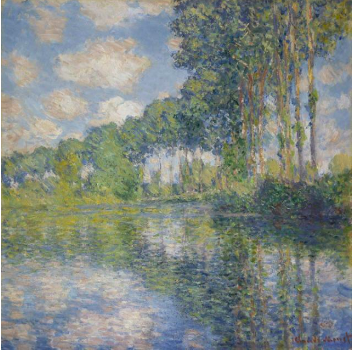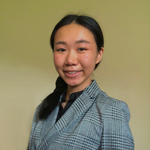(ART)ificial Intelligence
Main Article Content
Abstract
The Portrait of Edmund de Belamy looks like it could almost be framed in a museum. The painting depicts a portly gentleman wearing a dark frock coat and a plain white collar, perhaps the attire of a clergyman. It would be a very dignified composition, except for the fact that the artwork appears unfinished—the facial features are blurred, large swaths of canvas remain unpainted, and up close, the paintwork becomes a grid of mechanical-looking dots, resembling pixels. Even more strangely, in place of the artist’s signature, a cursive script scrawls out what appears to be an algebraic formula (see fig. 1).

Fig. 1. Portrait of Edmond de Belamy. 2018.
As one may have guessed, this portrait was not a product of the human mind. Rather, it was created by an artificial intelligence using the formula at the bottom right corner. When the Portrait of Edmond de Belamy went under the hammer in Christie’s Prints & Multiples sale on October 25, 2018, it sold for an incredible $432,500, signaling the arrival of AI art to the international auction stage (“Is Artificial Intelligence Set to Become Art’s Next Medium?: Christie’s”). The sale, however, sparked immediate controversy, and art admirers around the world all asked the same question: should the Portrait of Edmond de Belamy, and other computer-generated artwork, be considered art?
To art connoisseurs who value the stirring emotions behind each painting over its technicality, the answer was no. True art—or at least art worthy of nearly half a million dollars—is about passionate human expression, epitomized in the masterpieces of “geniuses” like Leonardo DaVinci and Vincent Van Gogh. According to Jonathan Jones, an art critic for The Guardian, “Computers would need to replicate human consciousness before they could replicate the funny thing humans do called ‘art’” (“A Portrait Created by AI”). He argues that because AIs are incapable of emotion, they cannot meaningfully replicate certain qualities that old masterpieces, such as the Mona Lisa (1503) or Starry Night (1889), do so well—and that if they eventually can, it would certainly mean the doom of both artistic expression and humanity. Such fear prevents serious discussion, and with many professional painters expressing the concern that computers will put them out of work, we might expect that computer-generated art would only reinscribe the established divisions between the mechanical and the creative. However, in a world governed by the new aesthetics born from digitalization, technology has already revolutionized the art market in numerous ways: it has provided artists with a versatile medium and a way to gain visibility, and has given art enthusiasts access to a wider range of art, reshaping the way the public interacts with it. By allowing technology to contribute to a creative production with a higher degree of autonomy, computer-generated art not only further blurs the boundaries between technology and art, providing new insights into how traditional elements of visual art may take form in new technological media, but also enables a new artistic style that eschews categorization, fusing a wide range of pictorial conventions into surprising new forms.
Contrary to what some skeptical art critics believe, AIs that create art are more than capable of having original artistic vision. Such algorithms are called creative adversarial networks (CANs), a term coined by Ahmed Elgammal, the director of the Art and Artificial Intelligence Laboratory at Rutgers University. Critics such as Jones often use the fact that CANs are trained on data sets of existing artworks to make the case that AIs can only mimic art, but otherwise don’t have the capacity to produce powerful stimuli in art such as novelty or surprise. However, this objection is a grave misunderstanding of the nature of CANs and intelligent machines. Perhaps no one would better enumerate the diversity of computer behavior than the father of modern-day computer science, Alan Turing, one of the first scientists to explore the possibility of creating a machine capable of human-like intelligence. In his article “Computing Machinery and Intelligence,” Turing points out the fallacies in the idea that machines “can ‘never do anything really new’ . . . can never ‘take us by surprise’” (450). Turing states that this view emerges from the mistaken assumption that “as soon as a fact is presented to a mind all consequences of that fact spring into the mind simultaneously with it” (451). In other words, he argues against the idea that the output of a program can always be determined by the input. In fact, with intelligent machines, because it is impossible for the programmer to know the state of the machine at each moment of the computation, the program more often than not produces a result that is unintentional or unpredictable. The programmers of CANs take advantage of this uncertainty to ensure that the algorithms produce novelty, something different from the images in the training data set, through what Turing calls a “random element” (459). In the Portrait of Edmond de Belamy, we see the random element take effect in the indistinctness of Edmond de Belamy’s facial features, portraying the subject in a manner that departs from the conventional depictions of 18th-century portraits. There is something weirdly contemporary in the deliberate distortion of Edmond’s face, and the abstract styles present in many other computer-generated artworks seem to suggest that AIs tend to produce works that mirror the course of art history—art’s long progression from figuration to abstraction. What critics fail to understand is that the purpose of CANs studying patterns in existing artworks is not to generate images consistent with such art, but to search for ways to transpose the imagery from the mix of influences into new works where color and form undergo reassessment. The greatest space for novelty, for computers and humans alike, lies in the potential future trends, in the unseen, and with AIs seemingly able to model art’s trajectory from the traditional to the new, it’s likely that the next original artistic movement will be born from computer-generated art.
Unfortunately, the new is often seen as a threat to the old, and the Portrait of Edmond de Belamy, as a product of art and science in conjunction, poses a challenge to the traditional idea of the “artistic genius.” Artistic genius has long been believed to be epitomized by the masterpieces of the greats, which many regard as shining representations of the ideals from their respective periods, from the Renaissance to Romanticism to Surrealism. While many art movements coincided with significant advancements in mathematics and sciences and often drew inspiration from such events, the emphasis of these great works typically lies in their imaginative qualities. For instance, Romantic art often delves into transcendental themes, while Surrealist art features dreamlike imagery. Consequently, the concepts of art and inspiration are often spoken of in mystical terms, elevated to a status beyond the realm of science and technology. In fact, the claim that Johannes Vermeer, the artist who famously painted the Girl with A Pearl Earring (1665), used some sort of optical device and mirror technology to help accurately recreate scenes within his paintings caused deep anguish for many art historians and critics, who accused the allegation of being “a depressing attempt to reduce genius to a trick” (Jones, “DIY Vermeer Documentary”). What, then, constitutes this so-called “genius”?
For centuries of art education, the “artistic genius” trope has always consisted of the Western canon of artists such as Leonardo da Vinci, Michelangelo, Claude Monet, and Johannes Vermeer, an understanding so closely linked to the privileges and traits associated with whiteness and masculinity that it suggests the very notion of “genius” is socially constructed. Ian Hacking explains in his essay “Making Up People” that it is human nature to classify things, though the act of classification in many cases “breeds conceptual confusion,” referring to how we have difficulty giving just consideration to observed behaviors that do not conform to our understanding of something. He laments that in attempting to measure genius through statistical means such as the IQ test, we have in turn abolished genius from our society. Hacking makes an argument against our classification of genius, yet ironically, in the process, he implies that true genius is to be associated with the great eras of art, reaffirming the idealized classification of “genius” that many critics of AI art use to prevent computer-generated artwork from being considered art. The idea that artistic genius is a valid classification, however, directly contradicts Hacking’s point about “real” and “finite” kinds. Hacking brings up John Stuart Mill’s argument that a “real kind” is a classification in which the members have “innumerable features in common,” while a “finite kind” is a classification in which members have very little in common. For example, our species, the homo sapiens, is a real kind because we share many biological features and characteristics, whereas races are just finite kinds because members of different races have only their race as a commonality. Upon close examination, the old masters regarded as artistic geniuses have few similarities; the diverse range of styles and expressive manifestations that their artworks contain reflects their existence as subjects of different social and cultural settings, artistic training, and schools of thought. “Artistic genius” is therefore merely a finite kind, making the current definition of “greatness” in art less about the aesthetics of the work produced or even the intentions behind the work, and more about whiteness, elitism, maleness, and Eurocentricity. The underlying issue is that “artistic genius” has long been centered on the mythos of the artists rather than the artworks themselves, a fact that has almost always worked against women and artists of color and now works against artificial intelligences. Any divergence from reality in the artist’s depiction tends to hold significance, but only if that artist is a man.1 For instance, the distortions within the Portrait of Edmond de Belamy greatly resemble Glenn Brown’s art-historical appropriations (“Biography”), yet while Glenn Brown’s art is praised for its technical virtuosity and passion, the Portrait of Edmond de Belamy is unfairly condemned to be a poor pastiche of genius.
To overcome this bias requires seismic social shifts, a reangling of how we view art history—as a history of the art, rather than of the artists. In “Automating Gender,” Jack Halberstam encourages us to confront our pre-existing ideas regarding Western society’s grand narratives, which in art is the myth that there are near-deities of creative wisdom, a superior kind of humanity that lives a more rarified human experience—white, European male artists. The prevalence of this myth, endorsed by art historians and art critics, places the works of “artistic geniuses” in the highest realm of art, not only establishing the legitimacy of these art historians and critics as experts in their knowledge of such art, but also guaranteeing the status of the artists of those works as old masters, perpetuating a gendered tautology that the artistic genius is male because men are most fit to be artistic geniuses. Through the lens of postmodernism, which Halberstam defines as a movement “embedded within the modern as interference or interruption and as a coming to consciousness of a subject no longer modeled upon the Western white male,” Halberstam affirms that questioning the interests served by the perpetuation of such grand narratives will lead to the conclusion that the ideas of artistic genius related to the allures of the great European art periods are unprogressive (446). From the politics of artificiality provided by postmodernism, it follows that “genius” is a socially manipulated idea that actually keeps us from getting a better understanding of the artworks studied and from exploring new avenues in art. Historical emphasis must be returned to the art rather than the artist. If we focus on the artwork created by CANs rather than the mechanical nature of the CANs themselves, perhaps we can see computer-generated art as less of a challenge to the prestige of human-made art, and more as a new artistic manifestation that subverts common distinctions between art and technology, the creative and the mechanical, and the old and the new.
In this sense, if we no longer focus on the mind or, particularly, the body behind a work, we might discover that the artworks created by CANs are just as impactful as artwork created by humans. Perhaps in this case we should also look to Turing for inspiration, and replace the question under consideration, “Can computers create art?”, with another: “Could a computer create artwork that could successfully trick a human into thinking it was created by another human?” If a satisfactory play of the Turing test, a test designed to see if an evaluator can distinguish between a human and machine through conversation, is enough to argue that machine intellect can be comparable to man’s, then a way to prove that computer-generated art is comparable to human art, surely, is to conduct a kind of visual Turing test, to show the output of the algorithms to human evaluators and ask if they can tell the difference (see figs. 2-3).

Fig. 2. Barrat, Robbie. 2018.

Fig. 3. Monet, Claude. Poplars on the Epte, 1891.
In fact, Ahmed Elgammal conducted a survey among viewers in a gallery specifically arranged for a visual Turing test, where computer-generated art was presented alongside human art. He found that many had a difficult time distinguishing between human art and computer-generated art, with several even claiming to be more inspired by the art done by a machine (“AI is Blurring the Definition of Artist”). The results of the poll affirm that the identity of a creator does not inherently grant more value to a work, and show that AIs are more than capable of creating aesthetic and thought-provoking works of art. Moreover, computer-generated artworks like the Portrait of Edmond de Belamy are in high demand by contemporary art enthusiasts, as evidenced by the passionate reception of the portrait and the final dealing price of nearly 5 times the price of an Andy Warhol print at the same auction. Both factors prove that computer-generated art can be just as artistically and socially meaningful as traditional art.
The success of the Portrait of Edmond de Belamy demonstrates that the future of art is now intertwined with the future of technology. New technologies not only benefit art critics and art historians, forcing them to reevaluate their preconceived notions of “artistic genius,” but also benefit art and artists, creating new tools and modes of expression. What people who worry that AI art is a harbinger of humanity’s destruction often forget is that there are humans behind the machines, a creator behind another creator of art. All computer-generated art is the result of human invention, software development, and other kinds of authorship. We must acknowledge that the human is always the creative force behind the work and that the computer is really just a helpful tool, albeit a little more complicated than a canvas and a paintbrush. But even if that were not true—even if AIs created art with complete independence and autonomy—the value of their work would not change. Technological development stimulates so much of the continued vitality of art, and new AI algorithms like CANs are just another means by which artists can transform art in positive ways, just as so many other technologies have in the past.
NOTE
- It’s important to note that there have been exceptions within the realm of human artists: exceptional individuals like Basquiat or Sofonisba, who are widely regarded as “artistic geniuses” despite deviating from conventional artistic norms, have made groundbreaking contributions to the world of art. The recognition and appreciation of their work has enriched our understanding of art, and highlights the importance of acknowledging and celebrating diverse talents in art, regardless of the nature of the artists.
WORKS CITED
“Biography.” Glenn Brown, Artlogic, https://glenn-brown.co.uk/biography/.
Elgammal, Ahmed. “AI Is Blurring the Definition of Artist.” American Scientist, https://www.americanscientist.org/article/ai-is-blurring-the-definition-of-artist.
Hacking, Ian. “Making Up People,” London Review of Books, vol. 28, no. 16, 2006, https://www.lrb.co.uk/the-paper/v28/n16/ian-hacking/making-up-people
Halberstam, Jack. “Automating Gender: Postmodern Feminism in the Age of the Intelligent Machine,” Feminist Studies, vol. 17, no. 3, 1991, pp. 439-460, https://www.jstor.org/stable/3178281.
Jones, Jonathan. “A Portrait Created by AI Just Sold for $432,000. But Is It Really Art?” The Guardian, Guardian News and Media, 26 Oct. 2018, https://www.theguardian.com/artanddesign/shortcuts/2018/oct/26/call-that-art-can-a-computer-be-a-painter.
‑‑‑. “DIY Vermeer Documentary Utterly Misses the Point about Old Masters.” The Guardian, Guardian News and Media, 28 Jan. 2014, https://www.theguardian.com/artanddesign/jonathanjonesblog/2014/jan/28/tims-vermeer-fails.
“Is Artificial Intelligence Set to Become Art's next Medium?” The First Piece of AI-Generated Art to Come to Auction | Christie's, Christies, 12 Dec. 2018, https://www.christies.com/features/A-collaboration-between-two-artists-one-human-one-a-machine-9332-1.aspx.
Turing, Alan M. “Computing Machinery and Intelligence,” Mind, vol. 59, no. 236, 1950, pp. 433–460, https://doi.org/10.1093/mind/LIX.236.433.

